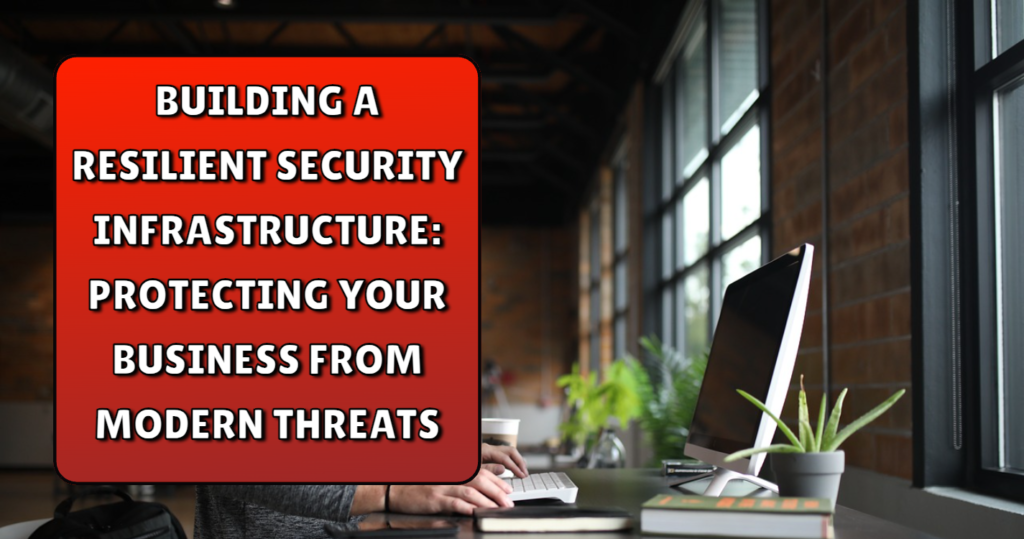Businesses face a wide array of threats, ranging from sophisticated cyberattacks to insider threats and physical breaches. To protect valuable assets, sensitive data, and business continuity, organizations must develop a resilient security infrastructure. This infrastructure acts as a shield, safeguarding the company against modern threats while ensuring adaptability in response to new risks. Below are some key strategies that businesses can employ to build and maintain robust security infrastructure.

1. Adopt a Layered Security Approach
A resilient security infrastructure is built on the concept of defense-in-depth, also known as a layered security approach. This strategy uses multiple layers of security controls to protect different aspects of the business, from network access to endpoint security.
- Perimeter Security: The first layer of protection consists of firewalls, intrusion detection systems (IDS), and intrusion prevention systems (IPS), which collaborate to monitor network activity and block unauthorized access attempts. These tools work proactively to identify and stop potential security threats before any harm is done.
- Endpoint Security: Devices such as laptops, smartphones, and servers should be secured with antivirus software, encryption, and regular patches to protect against malware and other threats.
- Access Control: Robust access control methods, like multi-factor authentication (MFA) and role-based access control (RBAC), ensure that only authorized individuals are granted access to critical systems and sensitive data. These measures enhance security by verifying users’ identities and restricting access based on specific roles and responsibilities within the organization. You can look into what is access provisioning to see how it can best work for your company.
Each layer adds a level of protection, making it more difficult for attackers to penetrate the system. The layered approach helps to mitigate risks and ensures that, even if one layer fails, others remain in place to protect critical assets.
2. Invest in Cybersecurity Awareness Training
Even the most sophisticated security system can be compromised by mistakes. Cybersecurity awareness training is crucial for educating employees on common threats, including phishing schemes, social engineering tactics, and best practices for maintaining strong password security. This training helps staff to recognize and avoid potential risks that could jeopardize the organization’s defenses. Employees are often the first line of defense, and without proper training, they may inadvertently compromise the security of the organization.
Training programs should be ongoing and updated regularly to reflect emerging threats. Businesses should also run simulated phishing attacks and other security drills to test employee responses and improve their vigilance against potential threats.
3. Utilize Advanced Threat Detection Tools
Conventional security methods, including firewalls and antivirus programs, are now insufficient to guard against contemporary cyber dangers. Companies need to implement sophisticated threat detection systems that use AI and machine learning technologies to detect and address unusual activities promptly.
- Security Information and Event Management (SIEM): SIEM solutions analyze log data from various systems to detect potential security incidents. This enables businesses to identify unusual patterns, such as multiple failed login attempts or large data transfers, which may indicate an attack.
- Endpoint Detection and Response (EDR): EDR solutions continuously monitor endpoint activity and use behavioral analytics to detect advanced threats, such as zero-day attacks or fileless malware.
These tools can provide early warning signs of an attack, allowing security teams to take proactive measures before a breach occurs.
4. Ensure Data Backup and Recovery Capabilities
A resilient security infrastructure also requires robust backup and recovery processes to ensure business continuity in the event of an attack, such as a ransomware incident. Regular backups—both on-premise and cloud-based—are critical to minimizing data loss and ensuring quick recovery in case of data corruption or destruction.
In addition to backing up data, businesses should regularly test their recovery plans to ensure that they can restore operations swiftly following a disaster. This includes verifying the integrity of backup data, testing recovery times, and ensuring that critical systems can be brought back online without delay.
5. Adopt a Zero Trust Security Model
The zero trust security model is a modern approach that assumes no user, whether inside or outside the organization, should be trusted by default. This model requires continuous verification of users and devices before granting access to any system or data. Zero trust involves implementing strict access controls, monitoring user activity in real time, and segmenting networks to limit the potential impact of a breach.
By minimizing trust levels and continuously validating users and devices, businesses can significantly reduce the risk of unauthorized access and data breaches, even if an attacker manages to infiltrate the network.
Conclusion
Building a resilient security infrastructure is essential for protecting a business from modern threats. By adopting a layered security approach, investing in employee training, utilizing advanced threat detection tools, and implementing zero trust principles, organizations can protect their critical assets and maintain operational integrity. Additionally, regular security audits and penetration testing ensure that vulnerabilities are addressed before they lead to catastrophic breaches. In an age of increasing cyber threats, a resilient security infrastructure is not just an option—it is a necessity.